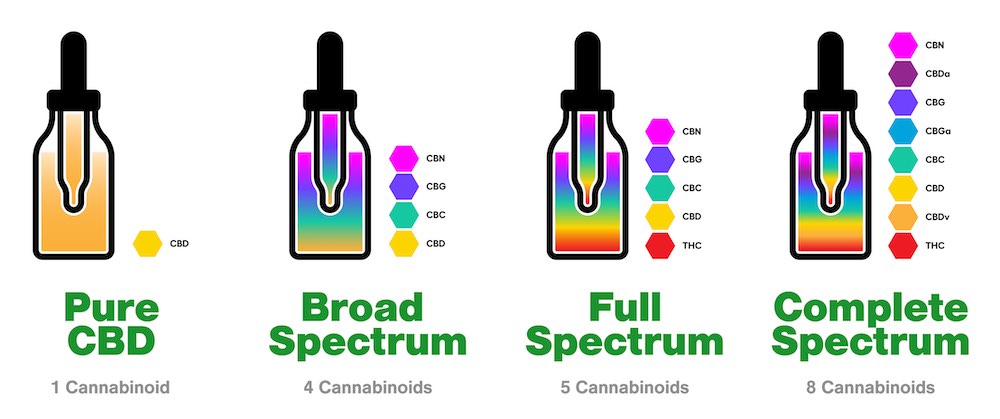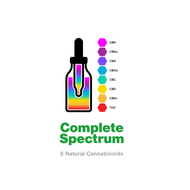What is Rainbow Complete Spectrum CBD Oil? Understanding CBDA and Acidic Cannabinoids.
Posted by Tweedle Farms on Jun 16th 2021

In honor of our new Rainbow Complete Spectrum CBD Oil, we figured it was time to explain the importance of CBDa and other acidic cannabinoids.
What is Complete Spectrum CBD Oil?
Our “Complete Spectrum” goes far beyond full spectrum CBD oil and other CBD tinctures. It’s a CBD product that contains a higher number of unique cannabinoids than any other oil on the market, as well as a higher amount of each one. In a single dropper, packed with 50mg of total cannabinoids, you’ll get CBD, CBDa, CBG, CBGa, CBN, CBC, CBDv, and THC as well as an intentional blend of steam distilled plant-derived terpenes.
What is CBDa? (and what's the difference between CBDa vs CBD?)
There are a wide variety of cannabinoids found in the cannabis plant, but in hemp, CBDa (cannabidiolic acid) is the most prevalent. Like all cannabinoids, CBDa stems from the “mother cannabinoid,” CBGa, and later converts to CBD over time, as well as when it is exposed to heat. So, CBD results from the decarboxylation of CBDa.
Because it is most abundant in raw cannabis (i.e. the raw hemp plant), the best way to consume CBDa is through the ingestion of a CBDa tincture or edibles, or via the use of other CBDa products such as topicals.
What is the Endocannabinoid System (ECS)?
Before we start to discuss the importance of CBDa and other acidic cannabinoids, we have to give you a quick refresher on what the endocannabinoid system (ECS) is and what it does.
The human body processes cannabinoids with the endocannabinoid system (ECS). The ECS makes endocannabinoids, which are neurotransmitters that are similar enough to the cannabinoids produced by the cannabis plant that the ECS can process cannabinoids as well.
The ECS is a vital part of the human organism. Endocannabinoids travel through the bloodstream, participating in every bodily process by attaching to cells and letting them know what’s happening in the body and what the cell should do.
So, what is CBDa good for? And why is it important?
Most cannabinoids bind directly with the body’s CB1 and CB2 cannabinoid receptors. When this takes place, the effects that we associate with cannabis-use are being felt. CBDa, on the other hand, interacts with our endocannabinoid system by blocking the COX-2 enzyme; an enzyme associated with inflammation.
Additionally, CBDa has been found to have 100 times the affinity for the body’s 5-HT receptors (especially the 5-HT1A serotonin receptors1), compared to CBD2. What does that mean? Well, when a chemical and a receptor have an affinity for each other, they are more likely to work together. This is an amazing thing, because 5ht receptors mediate neurotransmission. That means they act as an intermediary between your brain and your body, helping your body’s subconscious, and conscious, processes take place as smoothly as possible.
In fact, GW Pharmaceuticals, the company that produces Epidiolex, found CBDa to have a much higher bioavailability and faster onset than CBD in its own studies3.
Can you get high off cbda?
Nope! It is entirely non-psychoactive.
What about the other acidic cannabinoids? Why are they important?
Much like CBDa, acidic cannabinoids have been found, in general, to be easier for the body to metabolize and to have a higher rate of bioavailability.
Combined, those are the reasons why we are so excited to offer our new Rainbow Complete Spectrum CBD Oil. We can’t wait for you to try it.
~
Footnotes
- EM Rock et al. Cannabidiolic acid prevents vomiting in Suncus murinus and nausea-induced behaviour in rats by enhancing 5-HT1A receptor activation. Br J Pharmacol. 2013 Mar; 168: 6.
- Ethan Russo. Cannabis Therapeutics and the Future of Neurology. Frontiers in Integrative Neuroscience. 2018; 12: 51.
- Use of cannabinoids in the treatment of epilepsy. Patent application. GW Pharma



